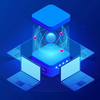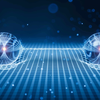
Quantum Machine Learning A Mathematical Voyage Beyond Classical Computation
Abstract
Quantum Machine Learning (QML) represents a nascent frontier where the principles of quantum mechanics are harnessed to redefine the paradigms of machine learning. By leveraging quantum superposition and entanglement, QML algorithms propose to process information in a highly parallelized manner, exploring a solution space exponentially large relative to its classical counterparts. This article provides a mathematical foundation for QML, tracing the journey from classical learning theory to its quantum generalization, detailing the core components of variational quantum algorithms, and contextualizing them within the practical constraints of the Noisy Intermediate-Scale Quantum (NISQ) era.
1. The Quantum Prelude: From Bits to Qubits
The fundamental unit of classical computation is the bit, a binary entity existing in a state of either 0 or 1. Quantum computation is built upon the qubit , whose state |ψ⟩ is a vector in a two-dimensional complex Hilbert space, \(\mathbb{C}^2\).
A single qubit state is described by:
\[|\psi\rangle = \alpha |0\rangle + \beta |1\rangle\]
where \(|0\rangle = \begin{bmatrix} 1 \\ 0 \end{bmatrix}\) and \(|1\rangle = \begin{bmatrix} 0 \\ 1 \end{bmatrix}\) form the computational basis. The complex probability amplitudes \(\alpha\) and \(\beta\) satisfy the normalization condition \(|\alpha|^2 + |\beta|^2 = 1\). Upon measurement, the qubit collapses to |0⟩ with probability \(|\alpha|^2\) and to |1⟩ with probability \(|\beta|^2\).
This superposition allows a single qubit to encode a continuum of states between |0⟩ and |1⟩. For \(n\) qubits, the state space becomes the tensor product of the individual spaces, \(\mathbb{C}^{2^n}\). A general \(n\)-qubit state is:
\[|\psi\rangle_n = \sum_{i=0}^{2^n-1} c_i |i\rangle\]
where \(|i\rangle\) are the \(2^n\) computational basis states (e.g., |00...0⟩, |00...1⟩, ..., |11...1⟩) and \(\sum_i |c_i|^2 = 1\). This exponential scaling of the state space is the source of quantum parallelism.
Quantum evolution is governed by unitary transformations. A gate acting on a qubit is a unitary matrix U (i.e., \(U^\dagger U = I\)). For example, the Hadamard gate, \(H = \frac{1}{\sqrt{2}} \begin{bmatrix} 1 & 1 \\ 1 & -1 \end{bmatrix}\), creates superposition: \(H|0\rangle = \frac{|0\rangle + |1\rangle}{\sqrt{2}}\).
Entanglement is a uniquely quantum correlation. The state \(|\phi^+\rangle = \frac{|00\rangle + |11\rangle}{\sqrt{2}}\) is maximally entangled. Measuring the first qubit and finding it to be |0⟩ instantly forces the second qubit into the |0⟩ state, and vice versa, regardless of the physical distance between them.
2. The Classical-to-Quantum Learning Bridge
Classical machine learning, at its core, is an optimization problem. A model with parameters \(\boldsymbol{\theta}\) maps an input \(\mathbf{x}\) to an output \(\hat{y}\). The goal is to minimize a loss function \(\mathcal{L}(\boldsymbol{\theta})\), often using gradient-based methods like Stochastic Gradient Descent (SGD):
\[\boldsymbol{\theta}^{(t+1)} = \boldsymbol{\theta}^{(t)} - \eta \nabla_{\boldsymbol{\theta}} \mathcal{L}(\boldsymbol{\theta}^{(t)})\]
In QML, the model is a parameterized quantum circuit (PQC), often called a variational quantum circuit or ansatz. The learning process becomes a hybrid quantum-classical loop:
- *Data Encoding (State Preparation): Classical data \(\mathbf{x}\) must be mapped onto a quantum state \(|\psi(\mathbf{x})\rangle\). Common techniques include:
* Angle Encoding: For each feature \(x_i\), apply a rotation gate: \(|\psi(\mathbf{x})\rangle = \bigotimes_{i=1}^n R_Y(2\pi x_i) |0\rangle^{\otimes n}\).
* Amplitude Encoding: The entire normalized data vector \(\mathbf{x} \in \mathbb{R}^N\) is directly embedded into the \(2^n\) amplitudes of the \(n\)-qubit state: \(|\psi(\mathbf{x})\rangle = \sum_{i=1}^N x_i |i\rangle\). This is highly efficient (logarithmic in resources) but difficult to prepare.
- *Variational Quantum Circuit (The Model): A parameterized unitary \(U(\boldsymbol{\theta})\) is applied to the encoded state.
\[|\psi(\mathbf{x}; \boldsymbol{\theta})\rangle = U(\boldsymbol{\theta}) |\psi(\mathbf{x})\rangle \]
This circuit, composed of layers of rotation gates (with angles \(\boldsymbol{\theta}\)) and entangling gates, is the quantum analog of a neural network layer.
- *Measurement and Loss Computation: The quantum state is measured, typically in the Z-basis, to obtain a classical expectation value. For a binary classification task, one might measure an observable \(O\) (e.g., \(Z \otimes I\)):
\[\hat{y} = \langle \psi(\mathbf{x}; \boldsymbol{\theta}) | O | \psi(\mathbf{x}; \boldsymbol{\theta}) \rangle\]
This expectation value \(\hat{y}\) is the model's prediction. A loss function, such as the mean-squared error \(\mathcal{L}(\boldsymbol{\theta}) = \frac{1}{M} \sum_{j=1}^M (\hat{y}_j - y_j)^2\), is computed classically.
- *Classical Optimization: The parameters \(\boldsymbol{\theta}\) are updated using a classical optimizer. Since calculating gradients directly on quantum hardware is non-trivial, we use techniques like the **parameter-shift rule**. For a parameter \(\theta_i\) and a loss function \(f(\theta_i)\), the gradient is estimated as:
\[\nabla_{\theta_i} f = \frac{f(\theta_i + \pi/2) - f(\theta_i - \pi/2)}{2}\]
This rule allows for exact gradient estimation using only two evaluations of the quantum circuit, analogous to finite differences but without approximation error for certain gates. The optimizer (e.g., SPSA, Adam) then updates the parameters: \(\boldsymbol{\theta} \leftarrow \boldsymbol{\theta} - \eta \nabla_{\boldsymbol{\theta}} \mathcal{L}\).
3. The Kernel Method: A Quantum Feature Space
A powerful perspective is the quantum kernel method. The encoding circuit \(\mathcal{U}_{\phi}(\mathbf{x})\) maps a classical data point \(\mathbf{x}\) to a quantum state \(|\phi(\mathbf{x})\rangle\) in a high-dimensional (exponentially large) quantum feature space. The inherent kernel function is the inner product between these quantum states:
\[K(\mathbf{x}_i, \mathbf{x}_j) = |\langle \phi(\mathbf{x}_j) | \phi(\mathbf{x}_i) \rangle|^2\]
This quantum kernel measures the overlap between the two data points in the quantum feature space. A Quantum Support Vector Machine (QSVM) uses this kernel to find a separating hyperplane in this high-dimensional space, which may correspond to a highly complex decision boundary in the original input space. The potential for a quantum advantage lies in kernels that are computationally expensive or impossible to compute classically.
4. The NISQ Reality and The Barren Plateau
The current era of quantum computing is the Noisy Intermediate-Scale Quantum (NISQ) era. Hardware limitations are significant:
* Noise: Gate errors (~\(10^{-3}\)), decoherence times (~100 µs), and readout errors (~1%) limit circuit depth and fidelity.
* Qubit Count: Current processors have 50-1000 qubits, insufficient for large-scale problems without error correction.
A fundamental theoretical challenge is the barren plateau phenomenon. For many random, deep variational quantum circuits, the gradient variance \(\text{Var}[\partial_{\theta} \mathcal{L}]\) decays exponentially with the number of qubits \(n\):
\[\text{Var}[\partial_{\theta} \mathcal{L}] \in \mathcal{O}(2^{-n})\]
This makes the gradient vanish, rendering optimization intractable. Mitigation strategies include using problem-inspired (as opposed to random) ansätze, local cost functions, and pre-training techniques.
5. A Glimpse into the QML Algorithm Zoo
* Quantum Neural Networks (QNNs): Deep parameterized circuits trained via hybrid loops, as described above.
* Quantum Generative Adversarial Networks (QGANs): A generator (a PQC) and a discriminator (either classical or quantum) are trained adversarially. The generator learns to produce quantum states that mimic the statistics of a training data distribution.
* Quantum Boltzmann Machines (QBMs): A quantum generalization of classical energy-based models. The system's configuration is described by a thermal state \(\rho = e^{-\beta H}/Z\), where \(H\) is a Hamiltonian containing both classical and quantum (non-commuting) terms, allowing it to represent more complex distributions.
6. Conclusion: The Path Forward
Quantum Machine Learning is not a panacea; it will not speed up every classical ML task. Its potential is most profound for problems with an inherent quantum structure, such as molecular simulation for drug discovery, or for tasks where a quantum feature map provides a decisive advantage.
Today, the field is focused on building and refining hybrid prototypes on NISQ hardware, demonstrating "quantum utility" for specific, small-scale problems. The mathematical framework, however, is robust and poised for a hardware breakthrough. Learning the language of QML-qubits, unitaries, expectation values, and variational principles-is to position oneself at the forefront of a computational revolution that may ultimately redefine the boundaries of artificial intelligence.












